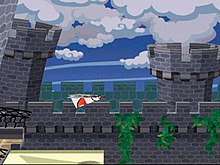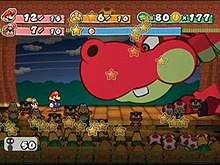Paper Mario: The Thousand-Year Door
Paper Mario: The Thousand-Year Door[lower-alpha 1] is a 2004 role-playing video game developed by Intelligent Systems and published by Nintendo for the GameCube. The Thousand-Year Door is the second game in the Paper Mario series.
| Paper Mario: The Thousand-Year Door | |
|---|---|
.jpg) Packaging artwork, featuring various characters from the game, with Mario at center. | |
| Developer(s) | Intelligent Systems |
| Publisher(s) | Nintendo |
| Director(s) | Ryota Kawade |
| Producer(s) | Shigeru Miyamoto Ryouichi Kitanishi |
| Programmer(s) | Tadao Nakayama |
| Artist(s) | Chie Kawabe |
| Writer(s) | Hironobu Suzuki Misao Fukuda |
| Composer(s) | Yoshito Hirano Yuka Tsujiyoko Saki Haruyama |
| Series | Paper Mario |
| Platform(s) | GameCube |
| Release | |
| Genre(s) | Role-playing |
| Mode(s) | Single-player |
The Thousand-Year Door borrows many gameplay elements from its predecessor, such as a drawing-based art style, and a turn-based battle system with an emphasis on action.[2] For the majority of the game the player controls Mario, although Bowser and Princess Peach are playable at certain points.[3] The plot follows Mario's quest as he tries to retrieve the seven Crystal Stars and rescue Peach from the X-Nauts.
The game was praised by critics. Critics generally praised the game's engaging plot and gameplay. The Thousand-Year Door won the "Role Playing Game of the Year" award at the 2005 Interactive Achievement Awards.[4] The game was followed by Super Paper Mario for the Wii in 2007.
Gameplay

The Thousand-Year Door has a unique visual style. The graphics consist of a mixture of 3D environments and 2D characters which look as if they are made of paper.[3] At different points in the game, Mario is "cursed" with abilities that enable special moves in the overworld, all of which are based on the paper theme. Mario can fold into a boat or a paper airplane by standing on a special activation panel, and roll up into a scroll of paper or become paper-thin.[2] The game's environments also follow this theme; for example, illusory objects that conceal secret items or switches can be blown away by a gust of wind due to the environment's paper-like qualities. In certain parts of the game, the player controls Bowser in multiple side-scrolling levels based on the original Super Mario Bros.. Additionally, the player controls Peach in the X-Naut Fortress at the completion of most game chapters.[3]
Battles in The Thousand-Year Door borrow elements from Super Mario RPG and the first original Paper Mario game.[5] The turn-based system, in which players select an attack, defense, or item from a menu, is augmented by timed button presses that can result in substantial attack or defence bonuses when performed correctly.[6] A similar "action command" was also used in all released Mario RPG games.[7] In The Thousand-Year Door, each of Mario's party members now have their own heart points (HP) and may receive any attack that Mario can receive. When a partner's heart points are reduced to 0, the partner becomes inactive for the rest of that battle and later battles until recovery. If Mario's Heart Points are reduced to 0, however, the game ends and the player must start again from the last saved point.[6] Flower Points—which are required for special moves—are shared among Mario and his party members. Defeating enemies awards various numbers of Star Points to Mario; for every 100 Star Points, Mario is able to level up, with the maximum level being 99.[2] With every level up, Mario can choose to upgrade his heart points (HP) by 5, flower points (FP) by 5, or his badge points (BP) by 3. The battles take place on a stage in front of an audience; if the player performs well in a battle, the audience can assist Mario by replenishing star power, throwing helpful items on-stage, or inflicting damage on the opponent.[3] Conversely, the audience may throw damage-causing items at the player or leave if the player performs poorly in a battle. For every 10 levels, the stage would increase by fifty audience members for a total of 200 after level 30.
Outside of battle, the game contains some strong role-playing video game traditions. For example, Mario's strength is determined by multiple statistical fields and status-boosting items that can be used in and outside of combat. The effects of these items range from healing Mario or his partner to damaging the opponent.[8] Mario can also purchase badges from non-player characters, find them hidden in the environment, or occasionally obtain them from defeated enemies. Each badge requires a certain amount of Mario's badge points (BP) in order to be equipped.[9] When equipped, these badges can permanently enhance a particular skill or aspect, or, in some cases, give Mario new moves, including Power Jump and Quake Hammer.[10] Throughout the game, Mario is permanently assisted by a party member. Each party member has a specialised skill, some of which are required to solve puzzles to advance progression in the game. More party members are gained as the player advances through the game, and party members' abilities can be augmented by collecting hidden Shine Sprites.
Plot
The Thousand-Year Door is set in the town of Rogueport, in the Mushroom Kingdom.[11] The majority of locations are not featured in previous Mario games. Most locations consist of a set theme; Glitzville, for example, is a floating city centered around a fighting arena known as the Glitz Pit.[12] The enemies and town inhabitants in the game range from recurring Mario characters, like Boo, to characters exclusive to the game, such as the X-Nauts. For many stages in the game, the story is presented in the context of a novel, and is divided into eight chapters (nine counting the prologue).[13]
Characters
The Thousand-Year Door contains several characters, the majority of whom are not playable. Progression in the game is sometimes dependent on interaction with non-player characters, although many are used in the game's various minor sidequests.[12] In particular, the Goomba Professor Frankly, who knows the most about the mysteries relating to Rogueport, must be visited every time Mario retrieves a Crystal Star. The game continues the tradition of Paper Mario, in which Mario can be accompanied by one assistant character at a set time.[8] There are seven party members in total: Goombella the Goomba, Koops the Koopa, Madame Flurrie the wind spirit, a Yoshi (named by the player), Vivian the Shadow Siren, Admiral Bobbery the Bob-omb, and Ms. Mowz the Squeek, who is available as an optional character.[14]
Mario is the main character of The Thousand-Year Door, although the story also rotates between portions where the player plays briefly as Princess Peach and Bowser. Most of Peach's story is spent on her interaction with the X-Nauts' computer AI TEC, who falls in love with Princess Peach despite not fully understanding the concept of love. Princess Peach agrees to teach TEC about love in exchange for the ability to contact Mario via e-mail.[15] The main antagonist of the Mario series, Bowser, tries to collect the Crystal Stars before Mario does instead of directly opposing Mario, though his attempts mostly become comedic relief.[2] Mario's younger brother Luigi is an NPC who recounts his slapstick adventures in the Waffle Kingdom, appearing in Rogueport with party members of his own, many of whom do not like Luigi at all for various reasons, juxtaposing the universal respect Mario's partners have for Mario. Ironically, Luigi winds up having his adventures actually printed and published. The books become best-selling novels that are eventually purchasable through the in-game item shops, though the stories told in the novels greatly exaggerate Luigi's heroics, compared to stories directly told by Luigi's disgruntled partners or even Luigi himself.
Story

The game opens with an introduction about a seaside town which was damaged by a cataclysm and consequently sunk into the depths of the earth. A town named Rogueport was later built at this site, with the fortunes of the lost kingdom fabled to exist behind the eponymous Thousand-Year Door, located in the ruins of the old town. Mario becomes involved when Princess Peach contacts him about a treasure map that she bought in Rogueport, but becomes part of a larger adventure after learning that Peach has gone missing.[11] With the help of Goombella and Professor Frankly, Mario learns that the map can potentially reveal the location of the seven legendary Crystal Stars, which are required to unlock the Thousand-Year Door.[13] Under the assumption that Peach herself is trying to find the Crystal Stars, he uses the map in an attempt to locate her.
In actuality, Peach has been kidnapped by the Secret Society of X-Nauts, a group of Moon-dwellers led by Sir Grodus, which is also searching for the Crystal Stars. While held captive, Peach uses e-mail via the main base's computer, TEC, to inform Mario about the quest and consequently help him to attain all seven Crystal Stars and locate the treasure.[15] However, the "treasure" is actually the Shadow Queen, a demon responsible for the ancient cataclysm that destroyed the original town 1,000 years ago. The X-Nauts had kept Peach so that her body could be possessed by the Shadow Queen in a bid to recover her full power. However, the Shadow Queen betrays Grodus. This happens, but the arcane power of the Crystal Stars is then used to separate Peach from her possessor briefly to give Mario and friends the strength needed to fight the Shadow Queen. Mario defeats the Shadow Queen and frees Peach, returning home with her.[16]
Development and release
Nintendo revealed The Thousand-Year Door at the Game Developers Conference of 2003.[17] Before its release, the game was confirmed to be a direct sequel to the Nintendo 64 game Paper Mario and was known tentatively as Mario Story 2 in Japan and Paper Mario 2 in North America.[18] A preview of the game was available at E3 2004; it included Hooktail Castle and a Bowser bonus level as playable stages.[19] The game was released on October 11, 2004, in North America.[17]
In 2008, Morgan Creek Productions filed a lawsuit against Nintendo alleging that they illegally used the song "You're So Cool" from the film True Romance in an advertisement for the game. Morgan Creek dropped the case six days later, after Nintendo revealed that the advertising agency, Leo Burnett USA, Inc., had licensing for the song.[20]
Reception
| Reception | ||||||||||||||||||||||||||
|---|---|---|---|---|---|---|---|---|---|---|---|---|---|---|---|---|---|---|---|---|---|---|---|---|---|---|
| ||||||||||||||||||||||||||
Paper Mario: The Thousand-Year Door received critical acclaim.[21] Critics particularly praised the plot: GameSpot's Greg Kasavin stated that "each [chapter] provides a thrill of discovery."[2], while Eurogamer's Tom Bramwell welcomed the whimsical storyline in comparison to traditional role-playing games, commenting that "[it is] something closer to Finding Nemo than Final Fantasy, which is very much a compliment."[23] The game's characters were also well received, with reviewers complimenting the use of NPCs and text.[3] Despite this, some commentators complained that the story developed slowly in the game's beginning stages.[3][28] Eurogamer rated the large amount of text as "the only major stumbling block" of the game.[23]
One of The Thousand-Year Door's main features, the use of a paper-based gameplay mechanic, was welcomed by reviewers.[2][23] When referring to the paper theme, 1UP commented that "It's a cohesive, clever approach that turns the game's visual style into more than just a look."[29] Critics also commented extensively on the game's battle system, which deviated from traditional RPGs.[2][23] GameSpy praised the use of timing in the battle system, stating that "these twitch elements were designed to be fun and engaging, and they succeed wonderfully at this."[30] Reviewers also praised the concept of having an audience to reward or berate Mario during battle.[2][23]
The game's visuals received a mixed response from critics. GameSpot enjoyed the game's presentation, writing that "it exhibits a level of visual artistry and technical prowess matched or exceeded by few other GameCube games."[2] Conversely, other reviewers complained that the graphics were not much of a visual upgrade from its predecessor, Paper Mario.[3] For the game's use of audio, IGN declared it "game music at its purest", but proceeded to question the absence of voice acting in the text based game.[3] RPGamer commented that the music "for the most part is done very well", but that the perceived repetitive battle music was "one of the biggest flaws" of the game.[28] The game won "Role Playing Game of the Year" at the 2005 Interactive Achievement Awards.[4] The game was ranked 56th in Official Nintendo Magazine's "100 Greatest Nintendo Games" feature.[31]
In its first week of release in Japan, The Thousand-Year Door was the best-selling game, selling about 159,000 units.[32] It proceeded to sell 409,000 units in the country[33] and 1.23 million copies in North America.[34] The game has since been included in the Player's Choice line.[35]
Notes
- Originally released in Japan as Paper Mario RPG (ペーパーマリオRPG)
References
- "Updated Australian Release List – 31/10/04". PALGN. October 31, 2004. Archived from the original on March 21, 2012. Retrieved August 9, 2009.
- Kasavin, Greg (November 12, 2004). "Paper Mario: The Thousand-Year Door for GameCube Review". GameSpot. Retrieved February 17, 2008.
- Schneider, Peer (October 11, 2004). "Paper Mario: The Thousand-Year Door Review". IGN. Retrieved February 17, 2008.
- "8th Annual Interactive Achievement Awards". Academy of Interactive Arts & Sciences. Retrieved September 16, 2008.
- Cole, Michael (October 24, 2004). "GC review: Paper Mario: the Thousand-Year Door". Nintendo World Report. Retrieved February 18, 2008.
- Clayman. "Game guide for Paper Mario: The Thousand-Year Door p. 2".
- "Action Command".
- Clayman. "Game guide for Paper Mario: The Thousand-Year Door p. 5". IGN.
- Paper Mario: The Thousand-Year Door instruction booklet. Nintendo. 2004. p. 26.
- Clayman. "Game guide for Paper Mario: The Thousand-Year Door p. 7".
- Paper Mario: The Thousand-Year Door instruction booklet (PDF). pp. 6–7.
- Clayman. "Game guide for Paper Mario: The Thousand-Year Door p. 12". IGN.
- Clayman. "Game guide for Paper Mario: The Thousand-Year Door p. 6". IGN.
- "Cheats for Paper Mario: The Thousand-Year Door (GameCube)". eLOOK.org. Archived from the original on February 27, 2008. Retrieved February 18, 2008.
- Iwasaki, Koji (May 1, 2005). "RPGFan Reviews — Paper Mario: The Thousand-Year Door". RPGFan. Retrieved February 18, 2008.
- Clayman. "Game guide for Paper Mario: The Thousand-Year Door p. 17". IGN.
- "GC 2003: Paper Mario on paper". IGN. August 21, 2003. Retrieved February 17, 2008.
- "Paper Mario 2 Official". IGN. March 31, 2004. Retrieved February 17, 2008.
- "Paper Mario: The Thousand-Year Door Preview". IGN. May 14, 2004. Retrieved February 17, 2008.
- Sinclair, Brendan (June 26, 2008). "Paper Mario suit turns out Paper Thin". GameSpot. Archived from the original on July 2, 2012. Retrieved June 28, 2008.
- "Paper Mario: The Thousand-Year Door for GameCube". GameRankings. Archived from the original on December 9, 2019. Retrieved July 7, 2020.
- "Paper Mario: The Thousand-Year Door for GameCube Reviews". Metacritic. Retrieved July 7, 2020.
- Bramwell, Tom (November 12, 2004). "Paper Mario: The Thousand-Year Door review'". Eurogamer. Retrieved February 17, 2008.
- Mason, Lisa (October 11, 2004). "Paper Mario: The Thousand-Year Door Review". Game Informer. Retrieved May 3, 2009.
- "Now Playing". Nintendo Power. 186: 140. December 2004.
- Cole, Michael (October 24, 2004). "Paper Mario: The Thousand-Year Door". Nintendo World Report. Retrieved May 3, 2018.
- Arushan, Zosha (September 15, 2004). "Paper Mario: The Thousand-Year Door". Nintendo World Report. Retrieved May 3, 2018.
- Whitehead, Anne Marie. "RPGamer: Paper Mario: The Thousand-Year Door Review". RPGamer. Archived from the original on October 6, 2008. Retrieved February 18, 2008.
- Parish, Jeremy (October 11, 2004). "Paper Mario: The Thousand-Year Door Review". 1UP.com. Archived from the original on January 5, 2010. Retrieved February 18, 2008.
- Lopez, Miguel (October 7, 2004). "GameSpy: Paper Mario: The Thousand-Year Door Review". GameSpy. Retrieved February 18, 2008.
- "60–41 ONM". ONM. February 23, 2009. Archived from the original on February 25, 2009. Retrieved February 24, 2009.
- "Paper Mario 2 Dominates charts". IGN. August 2, 2004. Retrieved February 18, 2008.
- "Japan GameCube charts". Japan Game Charts. Archived from the original on July 23, 2007. Retrieved February 18, 2008.
- "US Platinum Videogame Chart". The Magic Box. Retrieved February 18, 2008.
- "Four Nintendo GameCube Best Sellers Sport a New Price!". Nintendo. April 24, 2006. Archived from the original on January 17, 2007. Retrieved February 18, 2008.
External links
| Wikiquote has quotations related to: Paper Mario: The Thousand-Year Door |
